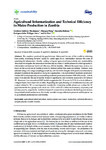Agricultural Informatization and Technical Efficiency in Maize Production in Zambia
| dc.contributor.author | Mwalupaso, | |
| dc.contributor.author | Wang, | |
| dc.contributor.author | Rahman, Sanzidur | |
| dc.contributor.author | Alavo, | |
| dc.contributor.author | Tian, | |
| dc.date.accessioned | 2020-07-09T16:19:21Z | |
| dc.date.available | 2020-07-09T16:19:21Z | |
| dc.date.issued | 2019-04-25 | |
| dc.identifier.issn | 2071-1050 | |
| dc.identifier.issn | 2071-1050 | |
| dc.identifier.other | ARTN 2451 | |
| dc.identifier.uri | http://hdl.handle.net/10026.1/15958 | |
| dc.description.abstract |
The cropland productivity gap between Africa and the rest of the world is widening. Fortunately, increasing farmers’ access to useful agricultural information reduces the costs of searching for information, thereby leading to higher agricultural productivity and sustainability. This study investigates the association between the adoption of mobile phones to collect agricultural information and farmers’ technical efficiency (TE) in Zambia. Different from previous studies, we focus on the actual use of mobile phones by farmers rather than mere ownership. Farmers were selected using a two-stage sampling procedure, and the Cobb-Douglas (CD) production function is adopted to estimate the association using two approaches—the conventional stochastic production frontier (SPF) and propensity score matching-stochastic production frontier (PSM-SPF) model. In both cases, we found that the use of mobile phones is significantly and positively associated with farmers’ TE. However, the conventional SFP model exaggerates the TE scores by 5.3% due to its failure to mitigate biases from observed variables. Regarding the agricultural growth indicators (income and output) related to TE, a close inspection reveals that increasing mobile phone use to close the TE gap between the two groups could result in a 5.13% and 8.21% reduction in severity of poverty and extreme poverty, respectively. Additional research is essential to corroborate the findings and analyze the potential causal mechanisms. Our study provides strong evidence to promote mobile phone use in agricultural production in rural Zambia. | |
| dc.format.extent | 2451-2451 | |
| dc.language | en | |
| dc.language.iso | en | |
| dc.publisher | MDPI AG | |
| dc.subject | agricultural informatization | |
| dc.subject | mobile phone use | |
| dc.subject | maize production | |
| dc.subject | technical efficiency | |
| dc.subject | sample-selection model: Zambia | |
| dc.title | Agricultural Informatization and Technical Efficiency in Maize Production in Zambia | |
| dc.type | journal-article | |
| dc.type | Journal Article | |
| plymouth.author-url | https://www.webofscience.com/api/gateway?GWVersion=2&SrcApp=PARTNER_APP&SrcAuth=LinksAMR&KeyUT=WOS:000467752200264&DestLinkType=FullRecord&DestApp=ALL_WOS&UsrCustomerID=11bb513d99f797142bcfeffcc58ea008 | |
| plymouth.issue | 8 | |
| plymouth.volume | 11 | |
| plymouth.publication-status | Published online | |
| plymouth.journal | Sustainability | |
| dc.identifier.doi | 10.3390/su11082451 | |
| plymouth.organisational-group | /Plymouth | |
| plymouth.organisational-group | /Plymouth/Faculty of Arts, Humanities and Business | |
| plymouth.organisational-group | /Plymouth/Users by role | |
| dcterms.dateAccepted | 2019-04-19 | |
| dc.rights.embargodate | 2020-7-15 | |
| dc.identifier.eissn | 2071-1050 | |
| dc.rights.embargoperiod | Not known | |
| rioxxterms.versionofrecord | 10.3390/su11082451 | |
| rioxxterms.licenseref.uri | http://www.rioxx.net/licenses/all-rights-reserved | |
| rioxxterms.licenseref.startdate | 2019-04-25 | |
| rioxxterms.type | Journal Article/Review |


